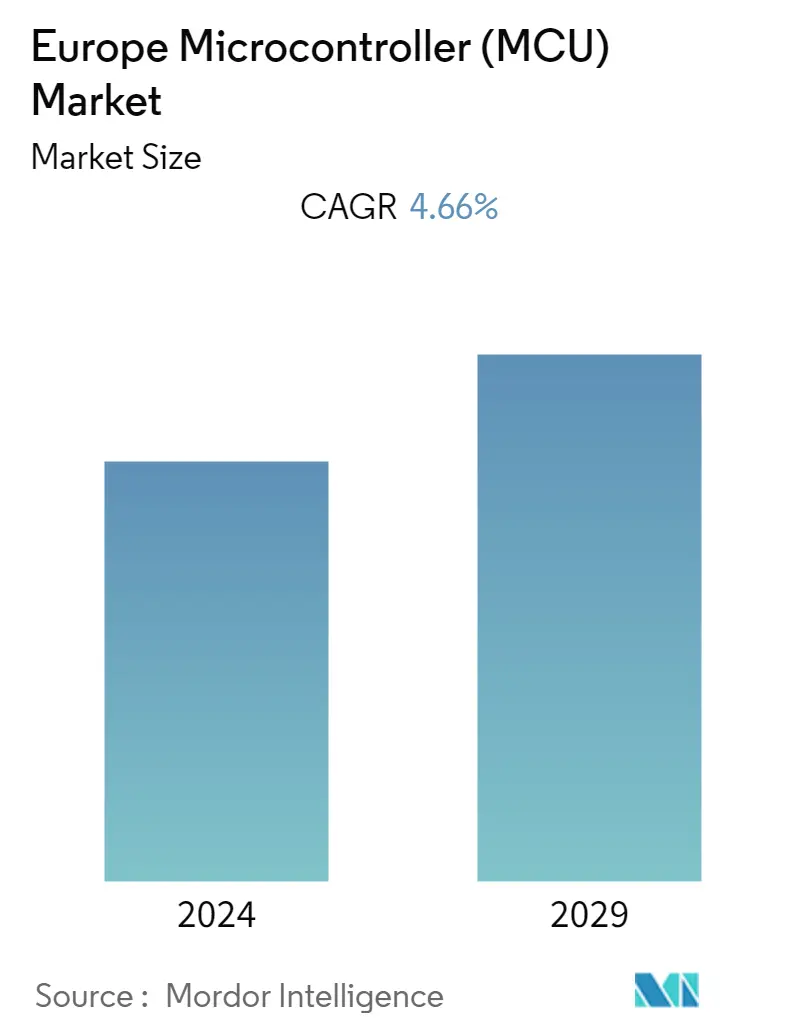Market Size of Europe Microcontroller (MCU) Industry

| Study Period | 2021 - 2029 |
| Base Year For Estimation | 2023 |
| Forecast Data Period | 2024 - 2029 |
| Historical Data Period | 2021 - 2022 |
| CAGR | 4.66 % |
| Market Concentration | Low |
Major Players_Market.webp)
*Disclaimer: Major Players sorted in no particular order |
Need a report that reflects how COVID-19 has impacted this market and its growth?
Europe Microcontroller (MCU) Market Analysis
The European microcontroller (MCU) market was valued at USD 2.47 billion in the previous year. It is expected to register a CAGR of 4.66% during the forecast period to reach a value of USD 3.31 million. The rising adoption of industrial automation and Industry 4.0 and the use of automated material handling systems such as industrial robots, COBOTs, rollers, and automated guided vehicles are fueling the demand for microcontrollers.
- High demand for hybrid and electric vehicles is anticipated to provide promising opportunities for the growth of the microcontroller industry. According to the National Automobile Manufacturers Association, Germany is the largest European plug-in electric vehicle sales market. Among European countries, German motorists purchased 681,900 plug-in electric vehicles in 2021. The development of advanced driver assistance systems (ADAS) also contributes to the development of autonomous vehicles, leading to the growth of the market studied.
- The increasing government support to increase digitization across various industries may fuel the European microcontroller (MCU) market. The Italian Ministry of Economic Development initiated the Industrial 4.0 (I4.0) National Plan, committing EUR 18 billion for the initiative. The program aims to transform traditional manufacturing methods with a focus on skills and advanced technology and support the digitization of the Italian economy. It emphasizes a future based on collaboration with other key initiatives across countries, further boosting the studied segment.
- The rising penetration rates of urbanization have increased the demand for advanced, aesthetically appealing products that can better serve consumers' requirements, such as multiple features in one device and time schedules. In addition, the vast millennial population across Europe has been quick to adopt smartwatches due to the high prices they can afford while tracking their regular work hours, further supporting market growth.
- The major factors restraining the market are the increasing complexity of MCU designs and the demand for high accuracy and precision of semiconductor devices. Microcontrollers generally have a complex structure. They cannot interface with a better power device directly. The number of executions is also limited. Microcontrollers are composed of complementary metal-oxide-semiconductor (CMOS) and can be damaged by a static charge.
- The COVID-19 outbreak significantly disrupted the supply chain and production in the market in the initial phase of 2020. However, as the supply chain gradually recovered in Q2 2020, governments of various regions enabled fiscal policies to recover the economy. These factors, combined with the rise of the stay-at-home economy, led to increased restocking demand from downstream clients, boosting revenue in the market studied.
